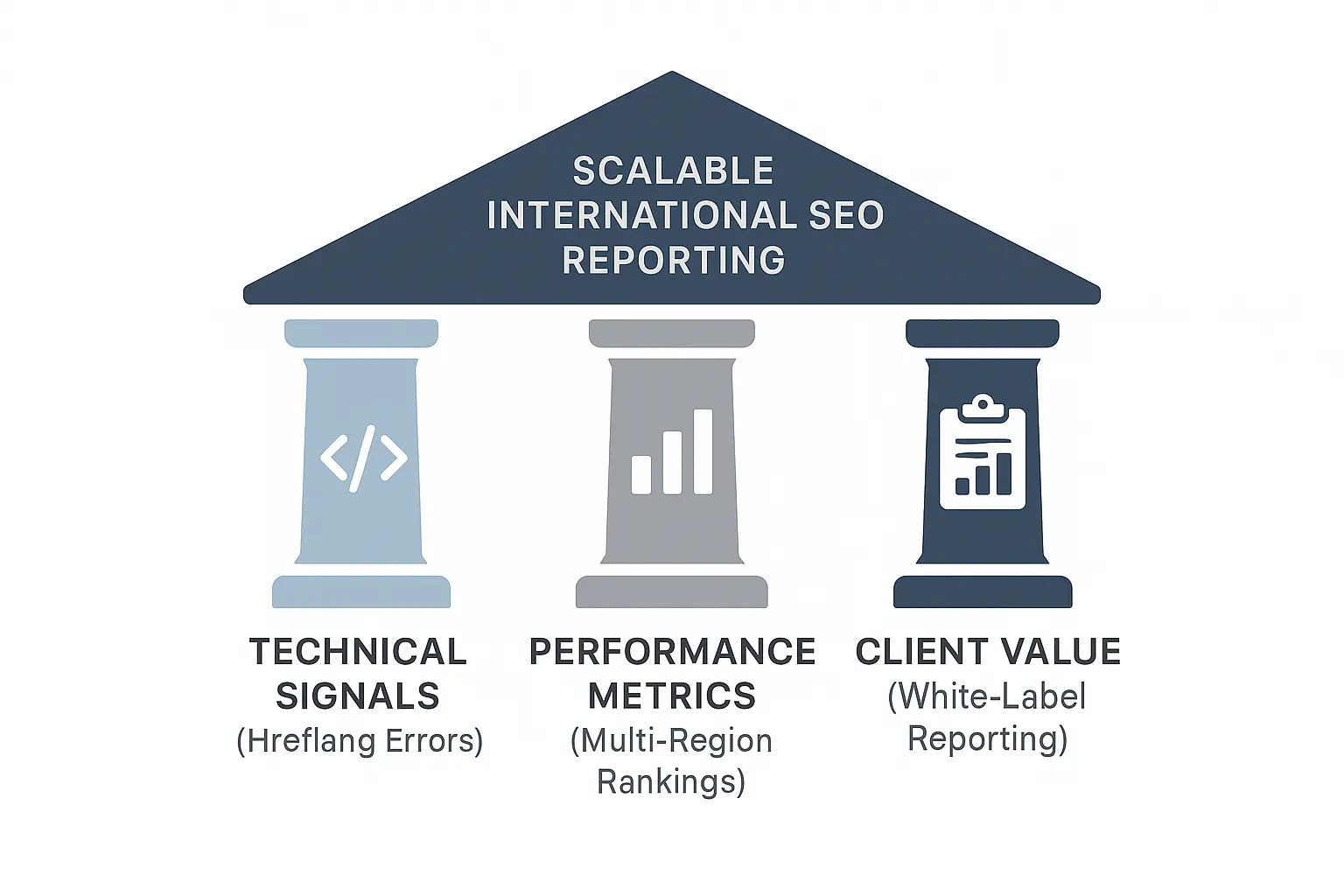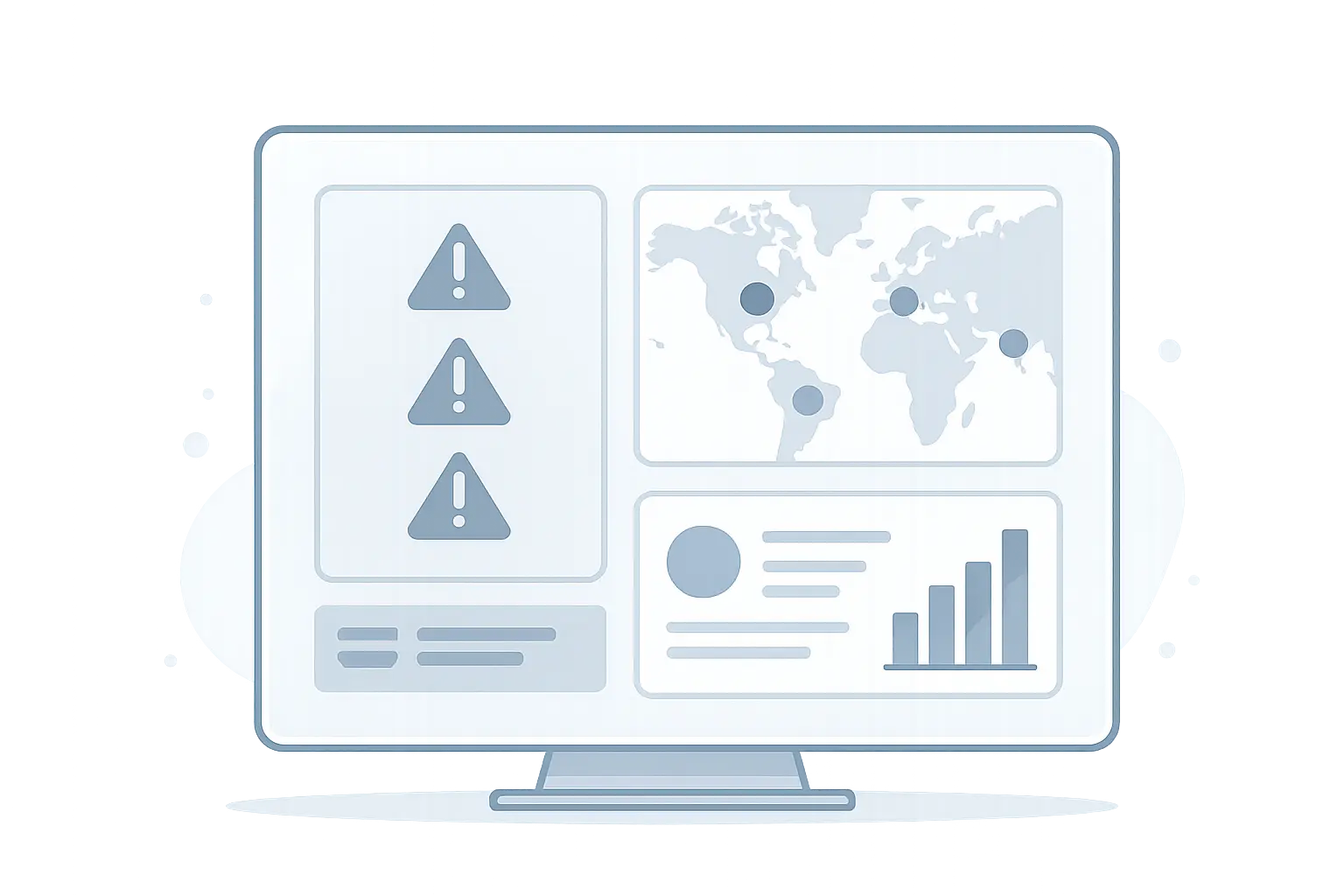Scalable Reporting for International SEO: How to Automate Hreflang & Rank Tracking
You landed the client’s international expansion. The German site is live, the French version is getting traction, and everyone is excited. But a nagging question keeps you up at night: when a user in Austria searches for the client’s product, are they seeing the German site intended for Germany, or a poorly translated version of the US homepage?
Manually checking this with a VPN feels like playing whack-a-mole. You fix one issue only for another to pop up. And when it’s time to build the monthly report, you’re stuck stitching together data from a dozen different sources, trying to tell a coherent story about global performance.
If this sounds familiar, you’ve hit the ceiling of manual international SEO. Expanding a client’s digital footprint across borders is one of the biggest growth levers for an agency, but it also introduces a layer of technical and reporting complexity that can quickly overwhelm your team. The truth is, traditional workflows weren’t built for this.
Why International SEO Reporting Breaks Traditional Workflows
Going global isn’t just about translating content; it’s about delivering a localized experience that builds trust and drives conversions. The data is clear: a CSA Research study found that 40% of consumers will not buy from websites in other languages, and 76% of online shoppers prefer to buy from sites that provide information in their native tongue. Get the language and localization wrong, and you’re leaving a massive amount of revenue on the table.
For agencies, proving the value of this work comes down to reporting. But international campaigns bring two unique, interconnected challenges that can turn reporting into a nightmare:
-
Technical Signals: Are you sending the right instructions to search engines for every country and language?
-
Performance Tracking: Are you accurately measuring visibility and rankings in each specific target market?
Manually managing these two pillars isn’t just inefficient—it’s a major drain on resources. Agencies report that manually tracking rankings across multiple countries can take up to 10-15 hours per client per month—a huge chunk of unbilled time that kills profitability.
To scale effectively, you need a system. It starts with mastering the most critical, and often misunderstood, technical signal in international SEO: the hreflang tag.
The Hreflang Headache: Speaking Google’s Language Correctly
Think of hreflang tags as a helpful set of instructions you give to Google. You’re essentially saying, “Hey Google, this is my page for English speakers in the United Kingdom, and this one over here is the correct page for English speakers in the United States.” This signal tells Google which localized version of a page to show users based on their geographic region or language.
It sounds simple in theory, but in practice, it’s one of the most challenging parts of technical SEO. In fact, Google’s own data suggests it’s a common source of confusion, and research from SEMrush found that over 50% of websites using hreflang tags have implementation issues.
These aren’t minor typos. Common errors can completely derail your international strategy:
-
Incorrect Codes: Using the wrong language or country codes (e.g., en-UK instead of the correct en-GB for the United Kingdom).
-
Missing Return Tags: This is the most frequent mistake. If Page A links to Page B as its Spanish equivalent, Page B must link back to Page A. Without this confirmation “handshake,” the instruction is ignored.
-
Pointing to Broken or Redirected Pages: Linking to a URL that results in a 404 error or isn’t the final, canonical version of the page.
When these errors pile up, Google gets confused. It might show your German page to users in France, fail to index a new regional site entirely, or even perceive your different language sites as duplicate content. The result is a poor user experience, lost traffic, and a client wondering why their investment isn’t paying off.

Beyond Hreflang: Are You Actually Winning in Each Market?
Fixing your hreflang tags is only half the battle. The other half is proving that your strategy is working by accurately tracking performance in each market.
A client in the UK doesn’t care about their rankings in the US; they want to know if they are visible on google.co.uk. Your German client needs to see their performance on google.de. Using a VPN to manually spot-check these rankings is not only time-consuming but also highly unreliable due to search personalization and location inconsistencies.
To effectively report on international SEO, you need a centralized dashboard that tracks keyword rankings across every target country. This is how you move from guessing to knowing. It’s the difference between telling a client “your traffic is up” and showing them “we’ve moved you into the top 3 for your primary keyword in the Australian market, driving a 40% increase in local leads.”

This level of granular, region-specific reporting is what separates a good agency from a great one. It demonstrates clear ROI and builds client confidence in your ability to manage their global presence.
The Path to Scalability: From Manual Audits to Automated Oversight
The old way of managing international SEO—with manual audits, messy spreadsheets, and hours of pulling data—simply doesn’t scale. To grow your agency and serve global clients profitably, you need to embrace automation.
A modern, scalable system for international reporting relies on three core components:
-
Automated Hreflang Audits: Instead of performing a manual check every few months, an automated system continuously crawls all site versions. It instantly flags broken return tags, incorrect codes, and other critical errors before they impact performance, allowing your team to fix issues proactively.
-
Centralized, Multi-Region Rank Tracking: The system automatically pulls keyword ranking data from every target locale (google.de, google.fr, google.es, etc.) into a single, unified view. No more VPNs or unreliable spot-checks.
-
Integrated, White-Label Reporting: The true power comes from combining technical health with performance metrics in one report, under your agency’s brand. You can show a client not just that their rankings improved in Spain, but that the improvement happened right after you fixed a series of critical hreflang errors on their Spanish subfolder.

This is the foundation of a scalable service. AI-powered SEO automation transforms an agency’s international offerings, freeing up teams from tedious manual tasks. Instead, they can focus on high-value work like developing sophisticated omnichannel growth strategies for clients. This automated approach is a core part of effective white-label SEO execution, enabling you to deliver expert-level results without the massive overhead.
Frequently Asked Questions (FAQ)
What is hreflang?
In simple terms, hreflang is a piece of code that tells search engines like Google which language and regional version of a webpage to show a user. It helps ensure that a user in Mexico sees the Spanish-language page intended for Mexico, while a user in Spain sees the version localized for Spain.
Why can’t I just use a VPN to check rankings?
While a VPN can give you a rough idea, it’s not a reliable tool for professional rank tracking. Search results are heavily personalized based on your exact location, search history, and device. Automated rank trackers use clean, non-personalized connections from servers physically located in the target country, giving you much more accurate data.
What’s the difference between language and region targeting?
Language targeting (en) tells Google to show a page to users who speak English, regardless of where they are. Region targeting (en-GB) is more specific, telling Google to prioritize that page for English-speaking users located in Great Britain. You can use both depending on your strategy.
How often should I check for hreflang errors?
Checking manually might only be feasible once a quarter, but code can be accidentally changed or deleted during any website update. This is why continuous monitoring is the best practice. An automated system that crawls your site regularly is the only way to catch errors in near real-time.
Your Next Step: Building a Global SEO Powerhouse
Manually managing international SEO reporting is a path to burnout, missed errors, and shrinking profit margins. The complexity is too high, and the stakes are too great to leave to chance.
Automation is the key to unlocking scalable, profitable, and impactful global SEO services. By systemizing how you monitor technical signals and track performance across regions, you can spend less time wrestling with spreadsheets and more time delivering strategic value that helps your clients win around the world.
Ready to see how a streamlined, automated approach can transform your agency’s global SEO offerings? Explore how a modern white-label SEO execution framework can help you scale without the in-house complexity.

